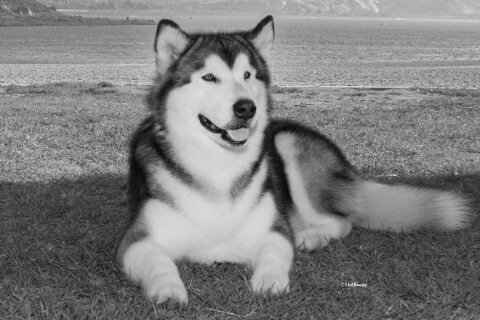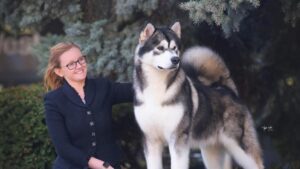
The Pro Shop: Amber Becker Briscoe
Amber Becker Briscoe shares her journey as a professional handler, from early mentorship to her memorable wins and insights on the sport.
Home » Meet The Breeds » Alaskan Malamute

The Alaskan Malamute is a powerful and resilient dog originally bred for hauling heavy freight across the vast Arctic tundra. Known for its size, strength, and endurance, the “Malamute” is highly regarded as both a loyal companion and a true pack animal in cold environments.
Working
23 – 25 inches
75 – 85 pounds
10 – 14 years
| Country of Origin | United States |
|---|---|
| Bred For | Sledge Dog |
| Known For | Strength, Endurance, Thick Coat, Facial Markings |
| Popularity | Moderate |
| Temperament | Affectionate, Loyal, Self-Confident, Strong-Willed |
| Activities | Hauling, Running, Conformation Shows, Dog Sports |
The Alaskan Malamute is one of the oldest Arctic sled dog breeds, with a history tracing back thousands of years. The breed was developed by the Mahlemiut people, an Inuit group from the Kotzebue Sound region of Alaska. These dogs were bred to assist in hauling heavy loads, pulling sleds, and performing other tasks essential to survival in the harsh Arctic environment. The Malamute’s strength, stamina, and ability to work in freezing temperatures made the dogs indispensable to their communities.
Unlike other sled dog breeds designed for speed, Malamutes were bred primarily for power and endurance. They were used to transport goods, and accompany hunters in the pursuit of seals and polar bears. Their loyalty and work ethic made them trusted partners for the Mahlemut people, and their thick double coats provided insulation against extreme cold.
The Malamute gained recognition outside Alaska as explorers and others began importing dogs for use in expeditions and sled races, and as working dogs. During the Klondike Gold Rush of the late 19th century, prospectors and settlers brought dogs with them and crossbreeding occurred. However, the Malamute remained distinct thanks to the efforts of indigenous groups who preserved its purity.
The breed gained further prominence during World War II, when Alaskan Malamutes were used by the US military for hauling supplies, search and rescue missions, and other critical operations. Their contributions to the war effort solidified their reputation as reliable and versatile working dogs.
The Alaskan Malamute was officially recognized by the American Kennel Club (AKC) in 1935 and is a member of the Working Group. Today, the breed is admired for its historical significance, physical power, and devoted nature. Although Malamutes are less commonly used for heavy hauling in modern times, they can excel in a variety of activities, including weight pulling, backpacking, and recreational sledding. They remain a popular choice for families who appreciate an affectionate and loyal companion with a rather striking, wolf-like appearance.
Male Alaskan Malamutes typically stand around 25 inches tall at the shoulder, weighing approximately 85 pounds. Females are slightly smaller, standing at 23 inches tall and weighing around 75 pounds.
The Alaskan Malamute is powerfully built and well-proportioned, with a compact and muscular frame designed for strength and endurance. The breed’s body is slightly longer than its height at the shoulders, and its deep chest and well-developed limbs support its ability to haul heavy loads over long distances.
Texture: The Alaskan Malamute has a double coat designed to protect against extreme cold. The outer guard hairs are thick, coarse, and water-repellent, while the undercoat is dense, woolly, and oily to provide insulation. The coat is of medium length, with longer hair on the shoulders, neck, back, and tail where it forms a waving plume.
| Standard Color | |
|---|---|
| Gray & White | y |
| Black & White | y |
| Red & White | y |
| Seal & White | y |
| Silver & White | y |
| White | y |
| Sable & White | y |
| Blue & White | y |
| Agouti & White | n |
| Standard Marking | |
|---|---|
| Black Mask | n |
| Gray Mask | n |
A Note About Color: The coat color of the Alaskan Malamute ranges from light gray through intermediate shadings of black, sable, and shadings of sable to red. The only solid color permitted is all white, and white is always the predominant color on the underbody, parts of the legs, feet, and as part of the facial markings. The guard hairs contain bands of color, with the lightest color at the base and the darkest color at the tip. Trimmings are shades of gold, cream, brown, buff, or red on the ears, facial markings, underbelly, and legs. These are located where the light and dark shades meet. Facial markings include an open (white) face, mask, star, blaze, cap, bar, and goggles. Chest markings include a necklace (single band of dark color) or an eagle emblem (two bands of dark that form a pattern).
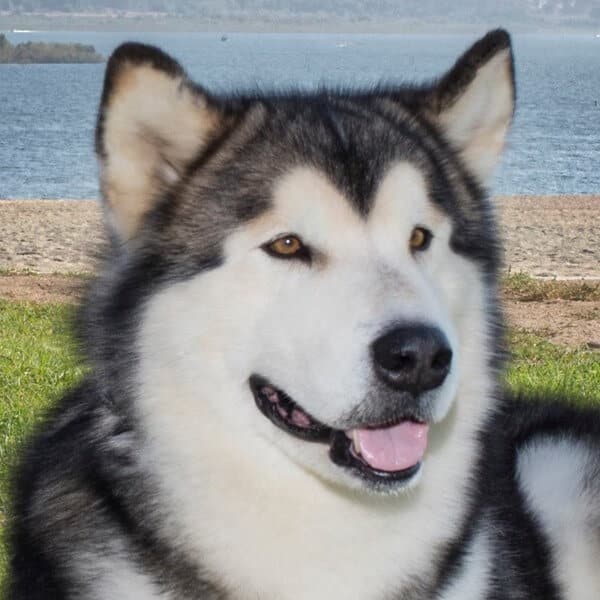
The tail of the Alaskan Malamute is heavily coated and carried over the back in a gentle curve. It is well-furnished with a plume-like appearance and is neither tightly curled nor flat against the back.
The Alaskan Malamute is a powerful, energetic breed that requires dedicated care and attention from potential owners. These dogs thrive in active households where their need for exercise, mental stimulation, and social interaction can be consistently met. Their friendly and loyal nature makes them excellent companions, but their strength and independence require experienced handlers who understand their working-dog temperament.
The Alaskan Malamute is generally a healthy breed with a lifespan of 10 to 14 years. Regular veterinary check-ups, a balanced diet, and an active lifestyle are crucial to maintaining overall health and well-being.
Although robust, the Alaskan Malamute can be prone to certain health conditions, including:
Alaskan Malamutes are friendly, outgoing, and affectionate dogs that form strong bonds with their families. They are known for their loyal and gentle nature, making them good companions for children, though their size and strength require adult supervision.
These dogs are independent thinkers, a trait inherited from their working-dog origins, which can make them appear stubborn at times. While they are generally friendly towards strangers and other dogs, early socialization is crucial to promote proper behavior and prevent dominance issues with other animals.
The Alaskan Malamute requires a high-quality diet that meets its energy needs while maintaining a healthy weight. Adult Malamutes typically consume 2.5 to 4 cups of dry dog food per day, divided into two meals, though this amount can vary depending on the dog’s size, age, and activity level.
Puppies need a diet formulated for large-breed growth, with meals split into three to four portions daily to support healthy development. Monitoring weight gain and adjusting portions as necessary is essential, as this breed can be prone to obesity. Fresh water should always be available, especially after exercise.
Alaskan Malamutes are intelligent and capable learners, but their independent and strong-willed nature can make training a challenge for inexperienced owners. Positive reinforcement methods, such as treats and praise, work best, as harsh corrections may cause resistance or distrust.
Early training and socialization are critical to establish boundaries and ensure that the Malamute is well-behaved in various environments. Recall training is particularly important, as the breed can have a strong prey drive and may wander off if given the chance. Consistency, patience, and engaging activities that challenge the mind will yield the best results with this breed.
Alaskan Malamutes are a high-energy breed that requires significant daily exercise to stay healthy and happy. These dogs thrive on activities like long walks, hiking, running, or pulling sleds or carts, which allow them to channel their strength and stamina.
| Energy Level | Moderate to High |
|---|---|
| Exercise Requirements | 2 Hours/Day (Minimum), Daily Walks, Vigorous Running, Regular Exercise, Mental Stimulation |
Without sufficient exercise, Malamutes can become bored and develop destructive behaviors, such as digging or chewing. Potential owners should be prepared to dedicate at least 1 to 2 hours per day to physical and mental stimulation.
The Alaskan Malamute’s thick double coat requires regular grooming to keep it in good condition. Weekly brushing is sufficient for most of the year, but during seasonal shedding periods, daily brushing is necessary to manage the heavy shedding.
| Coat Type | Short, Dense, Smooth, Shiney |
|---|---|
| Grooming Requirements | Weekly Brushing, Occasional Bathing, Routine Ear Cleaning, Periodic Nail Trimming, Regular Tooth Brushing |
Bathing is only needed occasionally, as the breed’s coat naturally repels dirt, and regular nail trimming, ear cleaning, and dental care should be part of the grooming routine. Checking for tangles, especially in the longer hair around the neck and tail, is essential to prevent matting.
Alaskan Malamutes are best suited to homes with ample space and a securely fenced yard, as their size and energy levels make them less suitable for apartment living. They are adaptable to cold climates and thrive in snowy conditions, but they can struggle in hot weather and require extra care to keep them cool.
These dogs are highly social and prefer to be part of the family, making them ill-suited for long periods of isolation. Potential owners should be prepared for a devoted companion that needs consistent attention, engagement, and companionship to live a full life.
Alaskan Malamute puppies are playful, curious, and full of energy, requiring early socialization and structured routines to grow into well-behaved adults. Introducing them to different environments, people, and animals during their early weeks of life helps to build confidence and ensures they adapt well to new situations.
Caring for an Alaskan Malamute puppy involves meeting the little one’s nutritional, physical, and social needs. The puppy should be fed high-quality large-breed puppy food that supports healthy growth while preventing overly rapid weight gain, which can strain developing joints. Meals should be divided into three to four portions daily.
Training should begin as soon as the puppy arrives home, focusing on basic commands, housetraining, and leash manners. Positive reinforcement methods work best, as Malamutes are intelligent but can also be strong-willed. Socialization during this stage is critical to ensuring the pup is comfortable with other dogs, people, and new environments.
Regular veterinary visits are essential during the first year for vaccinations, deworming, and monitoring growth. Establishing a grooming routine early, such as weekly brushing and nail trimming, helps the Malamute puppy become accustomed to handling and sets the stage for lifelong coat and hygiene care. Balancing exercise with rest is key, as overexertion can be harmful to the developing body. Interactive play and short walks will help to keep both body and mind engaged.
The Alaskan Malamute is recognized by the world’s leading registries and kennel organizations, which categorize the breed into a specific Group based on its unique characteristics. This breed is recognized worldwide under the following Group designations:
| Organization | Group Designation |
|---|---|
| AKC (American Kennel Club) | Working |
| UKC (United Kennel Club) | Northern |
| CKC (Canadian Kennel Club) | Working |
| ANKC (Australian National Kennel Council) | Utility |
| RKC (The Royal Kennel Club) | Working |
| FCI (Fédération Cynologique Internationale) | Group 5: Spitz and Primitive Type; Section 1: Nordic Sledge Dogs |
The ideal Alaskan Malamute is described by a Breed Standard that is approved by each of the world’s leading registries and kennel organizations. The Breed Standards for this breed may be found in the following links:
| Organization | Breed Standard |
|---|---|
| American Kennel Club | AKC Alaskan Malamute Breed Standard |
| United Kennel Club | UKC Alaskan Malamute Breed Standard |
| Canadian Kennel Club | CKC Alaskan Malamute Breed Standard |
| Australian National Kennel Council | ANKC Alaskan Malamute Breed Standard |
| The Royal Kennel Club | RKC Alaskan Malamute Breed Standard |
| Fédération Cynologique Internationale | FCI Alaskan Malamute Breed Standard |
Yes, Alaskan Malamutes shed heavily, especially during seasonal coat changes twice a year. Regular brushing helps to manage the shedding and keeps the thick double coat healthy.
No, Alaskan Malamutes are not hypoallergenic. Their shedding and dander can trigger allergies in sensitive individuals.
Alaskan Malamutes typically live between 10 and 14 years. Proper care, including regular exercise, a healthy diet, and routine veterinary check-ups, can support their longevity.
Yes, Alaskan Malamutes are excellent family dogs due to their friendly, affectionate, and loyal nature. However, their size and strength require supervision around small children.
Alaskan Malamutes are not frequent barkers, but they are very vocal and communicate through howls, grumbles, and other vocalizations. They may howl or vocalize when excited or seeking attention.

Amber Becker Briscoe shares her journey as a professional handler, from early mentorship to her memorable wins and insights on the sport.

Kumata Alaskan Malamutes blends 35+ years of passion, performance, and preservation to honor this powerful, snow-loving breed.

Interview with Mike Stone & Alisa Sylar, Silver Ice Alaskan Malamute breeders, sharing their purebred dog expertise and event experiences.
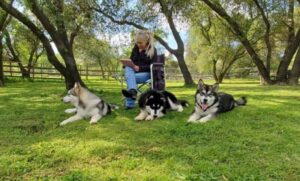
Alisa Syar is the breeder behind SilverIce Alaskan Malamutes. Read about the kennel’s beginnings, champions, Malamute puppies, photos & more!
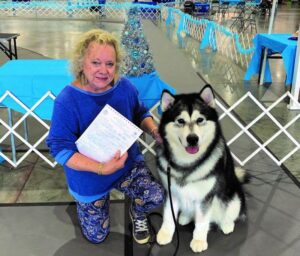
Vicky Jones is the breeder behind Vykon Alaskan Malamutes. Read about the kennel’s beginnings, champion dogs, puppies, photos & more!
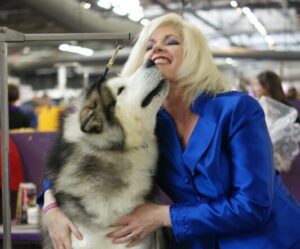
Interview with Working Group Breeder Pam Fusco Where do I live? How many years in dogs? How many years as a breeder?
The best way to ensure a long and happy relationship with a purebred dog is to purchase one from a responsible breeder. Not sure where to begin?
Contact the National Parent Club’s Breeder Referral Program, which is listed on the AKC Breeder Referral Contacts page.
